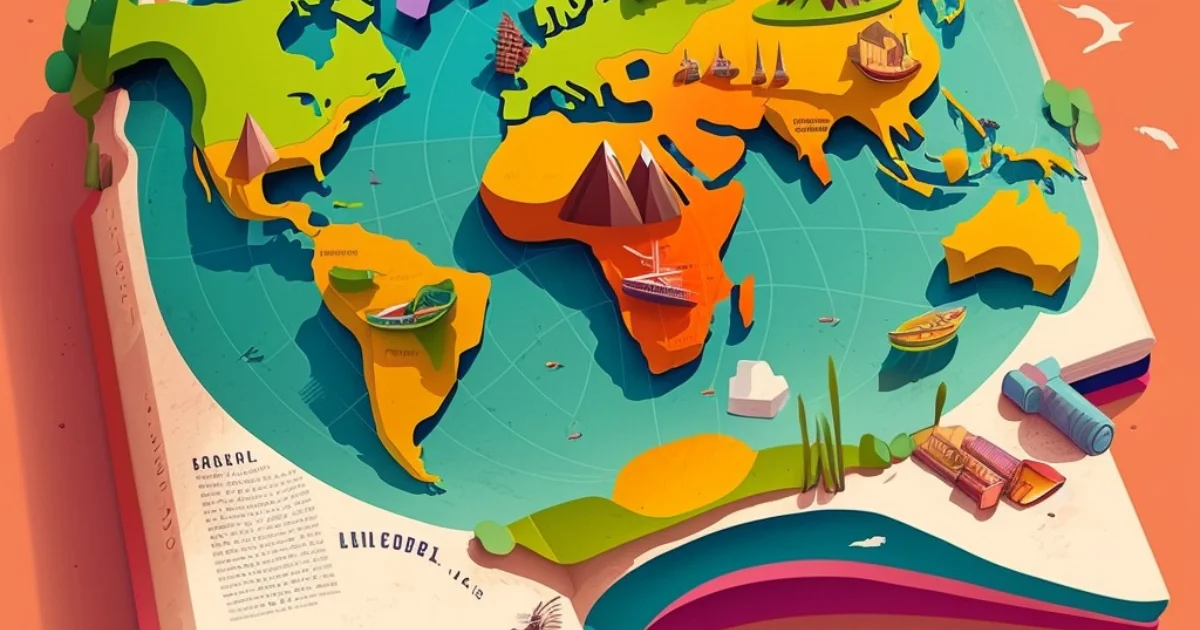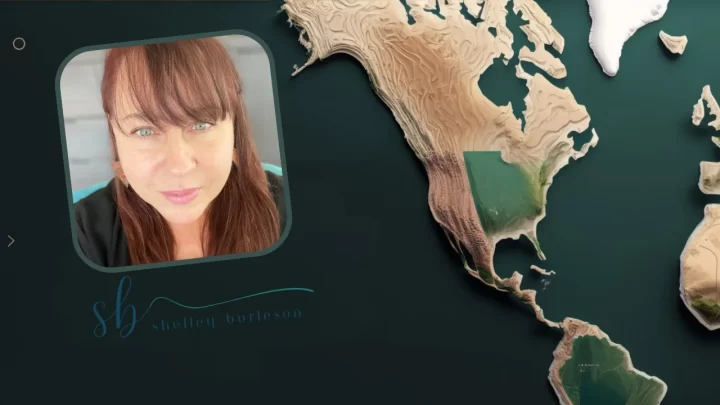This post may contain Amazon affiliate links which means, as an Amazon Associate, I may receive a small commission from purchases made through these links at no cost to you. I only recommend products I have personally used. To learn more, please see my privacy policy page.
Geography is the study of Earth’s natural and man-made features, including its landscapes, environments, and the relationships between people and their surroundings. It delves into how physical and human phenomena interact and shape the spatial aspects of the world we live in.
If you’re curious to explore further to answer the question “what is geography” in more depth, we’re about to dive deeper into the related types of geography and its disciplines – from physical and human to environmental and geographic information systems as well as geographic education – to uncover the fascinating insights each offer. So, grab your explorer’s hat and let’s embark on a journey to unravel the mysteries of the world around us! Read on…
So, What is Geography?
In this blog, I answer a wide array of sub-questions related to the big picture of “what is geography?” – from the simplest definition of geography to the diverse disciplines and major branches it encompasses. Get ready to explore the fascinating topics forming the idea of an integrated geography that helps us gain a better understanding of geographers and how they study aspects related to other branches of geography. As mentioned above, geography is the study of Earth’s natural and man-made features, including its landscapes, environments, and the relationships between people and their surroundings. It delves into how physical and human phenomena interact and shape the spatial aspects of the world we live in. Now, let’s dig a bit deeper!
What are Geography's 5 Main Branches?
Geography, as a multidimensional field, encompasses five main branches: physical geography, human geography, environmental geography, geographic information systems (GIS), and geography in education. Each branch offers a distinct perspective on the interactions between the Earth’s landscapes, the human societies inhabiting them, and the relationships between people and their environment. Let’s look at each one!

What is Physical Geography?
Imagine you’re on a grand adventure exploring the Earth’s natural wonders – from towering mountains to vast oceans and lush forests. Physical geography is like your trusty map, guiding you through these incredible landscapes and helping you understand the forces that shaped the natural environment. Physical geography is the branch of geography that’s all about the Earth’s physical features, the weather, and the amazing processes that make our planet so diverse. If you would like learn more, I wrote this article –> Physical Geography: A Beginner’s Guide.
Why is Physical Geography Important?
Think about how the earth’s surface and the natural environment evolved. Mountains rise, rivers flow, and oceans make waves – all thanks to the Earth’s processes. Physical geography helps us see the big picture by explaining why these changes happen. It’s like solving a giant puzzle of how the Earth’s mountains, oceans, and even the air we breathe are connected.
What's Included in Physical Geography?
Physical Geography falls within the physical sciences or hard science. From geomorphology, which delves into the formation and evolution of landforms like mountains and valleys, to climatology, which unravels the intricacies of weather patterns and climates, and hydrology, which investigates the movement and distribution of water across the Earth’s surface – each type of physical geography paints a picture of the forces that shape our world.
Through biogeography, we dive into ecosystems and the science of interactions between living organisms and their environments, while pedology uncovers the secrets of soils (yes, there is more than one kind of soil!) and their significance in sustaining life. And, that’s just to name a few!
Physical Geography in Action
- Landforms and Mountains: Have you ever wondered how mountains like the Himalayas were formed? Physical geography explains the powerful forces under the Earth’s surface that push the land upward, creating these breathtaking peaks.
- Weather and Climate: Curious about why some places are hot, and some are cold? Physical geography studies weather patterns, climate zones, and how the sun’s energy affects the world’s temperatures.
- Ecosystems and Biodiversity: From dense rainforests to vast deserts, physical geography shows us how different environments support unique plants and animals, and how they all work together in ecosystems.
- Natural Disasters: Ever heard about earthquakes, volcanoes, and hurricanes? Physical geography helps us understand why these natural events happen and how they impact people and the environment.
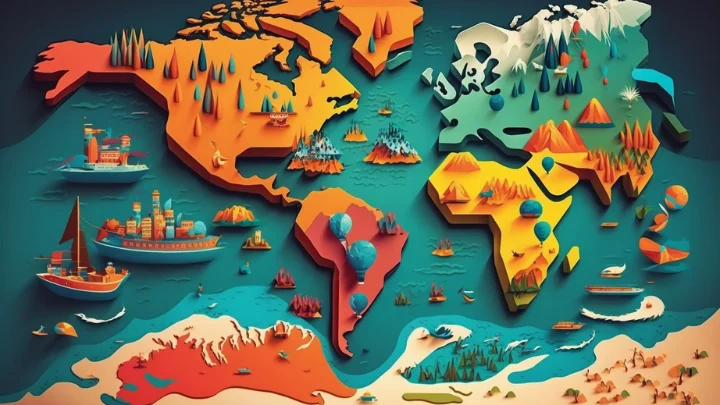
What is Human Geography?
Human geography shifts the focus to the interactions between people and their surroundings. It examines how human societies adapt to and modify their environment, giving rise to diverse cultures, languages, and traditions. Human geography investigates population distribution, migration patterns, urbanization, and the impact of human activities on the landscape. This type of geography unveils the stories of civilizations, from ancient cities to modern metropolises, and sheds light on the complex relationships between societies, economies, and the environments they inhabit.
Why is Human Geography Important?
Imagine you’re exploring a giant puzzle made up of people, cultures, cities, and nature. Human geographers help us put all those puzzle pieces together. Human geography shows us how people live, what they do for jobs, how they trade with others, and even how they impact the environment. By studying human geography, we get to peek into the stories of different communities and understand the connections between them.
What's Included in Human Geography?
Human geographers study an array of disciplines, each contributing a distinct perspective to our understanding of the world. At its core, it’s an integrated geography that bridges the realms of social sciences and natural sciences. Human geography is a discipline that includes a wide range of topics – from regional geography, which investigates the uniqueness of different areas and their dynamics, to urban geography, which dissects the intricate patterns of cities and the built environment they house. Historical geography dives into the past to illuminate how social change and human-environment interactions have shaped the present. Population growth, a facet often guided by the principles of social sciences, examines the patterns and factors that influence how regions thrive and evolve. Social relations are a vital part of human geography that seeks to understand the complicated connections that shape societies and regions.
Human Geography in Action
- Cultural Landscapes: Have you ever wondered why cities have different buildings and styles? Human geography helps us see how cultures shape the way cities look, from ancient temples to modern skyscrapers.
- Urbanization: As more people move to cities, human geography studies how these urban areas grow, what challenges they face, and how they impact the environment.
- Language and Communication: Human geography helps us understand why people speak different languages and how they use them to express their ideas and connect with others.
- Migration Patterns: Have you ever met someone from a different country? Human geography looks at why people move from one place to another, whether it’s for better opportunities or escaping difficult situations.
- Cultural Diffusion: Human geography explores how cultures and ideas spread from one place to another. Ever wondered why we enjoy foods from different parts of the world? That’s cultural diffusion in action!

What is Environmental Geography?
Bridging the gap between physical and human aspects, environmental geography explores the intricate connections between humans and the natural world. Environmental geography examines the ways in which human activities influence ecosystems, biodiversity, and the overall health of the planet. Environmental geography plays a crucial role in understanding and addressing environmental challenges, such as climate change, pollution, and resource depletion.
Imagine you’re on a quest to uncover the secrets of our planet’s health – from the lush rainforests to the clear blue oceans. Environmental geography is like your compass on this journey, helping you understand how humans and nature interact, the impact of our actions on the environment, and how we can create a sustainable future. It’s the branch of geography that explores the delicate balance between people and the planet we call home.
Why is Environmental Geography Important?
Picture the Earth as a giant puzzle, with humans and nature fitting together. Environmental geographers help us see the pieces and understand how they connect. Environmental geography is like solving a puzzle to find the best ways to take care of our planet, ensuring that future generations can enjoy its natural resources too.
What's Included in Environmental Geography?
Environmental geography is a multidisciplinary field where the natural and social sciences converge to study complex relationships between humans and their environment. It’s a science that transcends boundaries, uniting environmental geographers around the world. From the pressing issue of global warming to the broader spectrum of environmental problems, environmental geography uses spatial data and spatial analyses to understand the challenges our planet faces. Environmental geographers investigate how increased resource consumption influences the delicate balance of nature. In essence, looking at the environment helps us understand environmental problems with contributions from both the natural and social sciences, guiding us toward sustainable solutions for a harmonious coexistence with our environment.
Environmental Geography in Action
- Climate Change and Global Warming: Curious about why the Earth’s temperature is changing? Environmental geography digs into factors like greenhouse gases and deforestation to explain how human activities affect the climate.
- Biodiversity and Conservation: From protecting endangered animals to preserving rainforests, environmental geography helps us understand why biodiversity is important and how we can keep our planet’s diverse life thriving.
- Sustainable Living: Ever heard about reducing, reusing, and recycling? Environment geography teaches us how to live in harmony with the Earth by using resources wisely and reducing our impact.
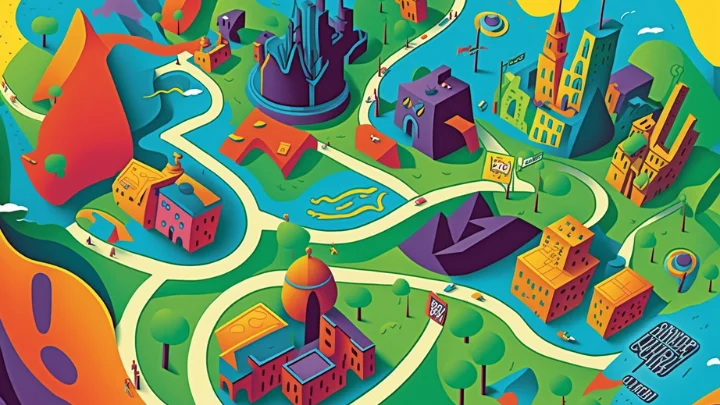
What is Geographic Information Systems (GIS)?
Why is GIS Important?
Think of GIS as a detective’s magnifying glass, helping us uncover hidden connections between places and data. From tracking the spread of diseases to planning the most efficient routes for emergency responders, GIS helps us make better decisions by considering spatial context.
What's Included in GIS?
GIS is a dynamic field that draws on diverse disciplines to craft a comprehensive view of the world. Geographers play a central role in this endeavor. Within GIS, disciplines such as cartography and computer cartography combine artistic skills with technological advancements to create maps that visually visualize data. Remote sensing involves collecting information about the Earth from a distance, enabling us to analyze changes and trends over time. Integrated geography takes center stage once again, as GIS uses both qualitative methods, delving into the nuanced understanding of societies, and quantitative methods, which harness numerical data for comprehensive analysis. In essence, GIS serves to reveal hidden patterns, spatial relationships, and related insights that empower us to make better decisions for the future.
GIS in Action
- Urban Planning: City planners use GIS to analyze data about population density, transportation routes, and land use, allowing them to design more sustainable and functional urban spaces.
- Natural Resource Management: GIS helps in monitoring and managing resources like forests, water bodies, and agricultural land, ensuring their sustainable use and protection.
- Disaster Management: During natural disasters, GIS helps responders understand the affected areas, plan evacuation routes, and allocate resources efficiently.
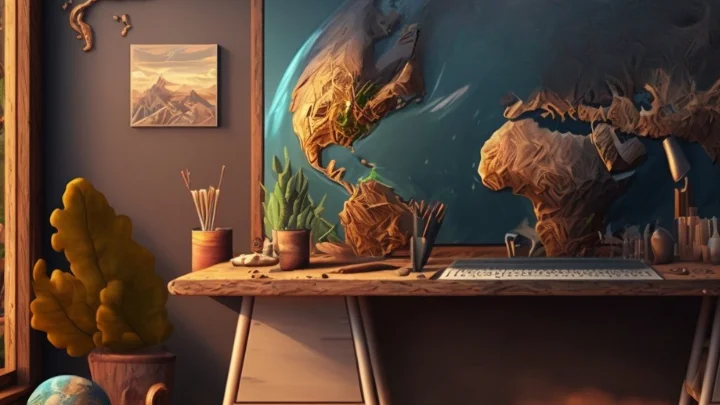
What is Geography in Education?
Geography in education is like a passport that opens doors to understanding, empathy, and a deeper connection with the world. By nurturing curious minds and fostering a sense of responsibility, it shapes students into informed global citizens who are prepared to tackle the challenges of a dynamic world. Imagine a world where young minds are curious explorers, eager to understand the mysteries of the Earth and its diverse cultures. Geographical education is the guiding compass in this journey, nurturing a deep appreciation for the world around us. It’s the field that’s all about teaching and learning geography – not just as facts and figures, but to understand the connections between people, places, and the environment.
Why is Geography in Education Important?
Think of geographic education as the key that unlocks a treasure trove of knowledge about our planet. It empowers students to think critically, ask questions, and view the world through a global lens. By learning geography, students gain a holistic understanding of our interconnected world and the challenges and opportunities it presents.
Geographic Education in Action
- Global Awareness: Geographical education helps students understand the world’s cultures, traditions, and how people across the globe live and interact.
- Environmental Stewardship: Students learn about the environment and their role in preserving it, inspiring future generations to be responsible caretakers of the Earth.
- Problem-Solving Skills: Through geography, students develop skills to analyze complex issues, consider various perspectives, and propose solutions that address real-world challenges.
How Do We Use Geography in Everyday Life?
Geography isn’t just about maps and distant places; it’s the invisible thread that weaves through our lives, guiding us in ways we might not even realize. From our morning routines to planning a vacation, geography plays a significant role in shaping our everyday experiences.
Why is Geography in Everyday Life Important?
Consider geography as the silent partner in your daily adventures. It helps you understand the world around you and make informed choices. Whether you’re choosing what to wear based on the weather or deciding where to live based on transportation options, geography offers insights that enhance the quality of your life.
Geography in Action
- Morning Commute: Before you leave for work or school, you check traffic and choose the best route using navigation apps, which rely on geographical data for accurate directions.
- Local Food Choices: When you shop for groceries, the choices you make are influenced by where the food comes from, its seasonality, and its impact on the environment.
- Weather Decisions: Your choice of clothing, outdoor activities, and travel plans are often determined by the weather forecast, which is a product of geographical data and meteorology.
- Choosing a Home: When considering a new place to live, factors like proximity to work, schools, and amenities are influenced by geographical considerations.
- Cultural Awareness: Interacting with people from different cultures broadens your perspective and helps you appreciate the diverse geographical backgrounds that shape their experiences.
Wrap Up...
So, what is geography? Geography is your treasure map to discover all the exciting things about our world. It helps you understand where different places are, what makes them special, and how people and the natural environment work together to create the incredible planet we call home.
Geography is like a magical key that unlocks secrets about mountains, oceans, cities, and even the weather. It’s about figuring out why some places are hot, and some are cold, why rain falls from the sky, and why animals live in certain areas. By learning about geography, you become a super explorer who understands why maps have different colors and shapes, and you can even help protect our Earth by taking care of it.
So, next time you look at a map, remember that geography is your guide to understanding all the wonderful places and stories that make our world so special. It’s like a treasure hunt where you get to learn about everything from the tiniest bugs to the tallest mountains and have fun exploring the incredible planet we all share!
Geography, though, is not just about maps; it’s about understanding our world and the dynamic relationships that shape it. From the diverse environments we inhabit to the ways human societies interact with nature, geography provides insights that are crucial for our global well-being. So, as you go about your daily life, remember that you’re an active part of the ever-evolving geography that surrounds us all.
In essence, these branches of geography work together to provide a comprehensive understanding of our world. They offer diverse lenses through which we can unravel the mysteries of our planet’s past, present, and future. Whether it’s exploring the physical forces that shaped our landscapes, delving into fascinating human societies, or advocating for the

